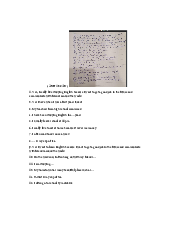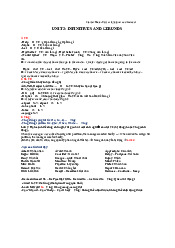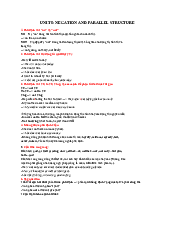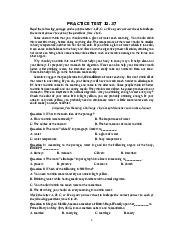







































Preview text:
Object Oriented Analysis and Design – Part2
Q. 1 Which statement is true about elements within the subsystem and public visibility?
A. Only the subset of elements that define the subsystems API should have public visibility.
B. Only the subsystem proxy class should have public visibility.
C. No elements inside the subsystem should have public visibility.
D. Only the elements that reference external classes should have public visibility.
Q. 2 What are the two types of dependency that can be used from a subsystem? (Choose two.)
A. <> dependency to a subsystem interface
B. an <> dependency to a package containing used classes
C. a <> relationship to a node in the Deployment model
D. a <> relationship to one or more collaboration occurrences
Q. 3 Which task is performed during use-case realization refinement?
A. identify participating classes
B. allocate responsibilities among classes
C. model messages between classes
D. model associated class relationships
Q. 4 Which statement is true about design subsystems?
A. They partially encapsulate behavior.
B. They represent an independent capability with clear interfaces.
C. They model a single implementation variant.
D. They can only contain design classes.
Q. 5 Given the following configuration: Package A, which contains class aClass is in
the presentation layer. Package B, which contains a class bClass and an interface
bInterface is in the business layer. Package C, which contains cClass is in the data
layer. Which is a poor practice?
A. aClass calls a method in bClass.
B. aClass has an attribute of type cClass.
C. aClass realizes bInterface.
D. bClass realizes bInterface.
Q. 6 Which process document describes design mechanisms, any mappings between
design mechanisms, and the details regarding their use?
A. Software Architecture Document B. Design Guidelines C. Vision Document D. Software Development Plan
Q. 7 In the state of a state machine, a behavior can be defined _____. A. before reaching a state B. upon reaching a state C. upon leaving a state D. inside a state Q. 8 What is a gate?
A. a parameter that represents a message that crosses the boundary of an interaction or interaction fragment
B. a defined protocol for accessing the internals of a subsystem
C. a decision point in a state machine that has more than two alternatives
D. a set of checkpoints each subsystem design must satisfy bef r o e it can be assigned for implementation
Q. 9 When identifying design elements, a simple analysis class will map to a(n)_____. A. active class B. interface C. design class D. subsystem
Q. 10 In which OOAD activity is the distribution mechanism identified?
A. Identify Design Elements B. Identify Design Mechanisms C. Class Design D. Architectural Analysis
Q. 11 Click on the exhibit button In the diagram, what is E? A. fork B. initial state C. decision D. transition E. final state F. event G. state H. guard condition
Q. 12 Identify Design Elements is part of which workflow detail?
A. Define a Candidate Architecture B. Design Components C. Perform Architectural D. Refine the Architecture
Q. 13 Click on the exhibit button In the diagram, what is H? A. fork B. initial state C. decision D. transition E. final state F. event G. state H. guard condition
Q. 14 What is the relationship between operation and method?
A. The terms are synonymous.
B. An operation describes how a method is implemented.
C. A method describes how an operation is implemented. D. There is no relationship.
Q. 15 Why would you use subsystem interfaces rather than subsystem instances on sequence diagrams?
A. to make it easier to model subsystems during Subsystem Design
B. to make use-case realizations easier to change
C. to ease sequence diagram maintenance when message signatures change
D. to reduce the number of classes needed to implement the subsystem
Q. 16 Which is an input artifact to the Identify Design Elements activity? A. Deployment Model B. Implementation Model C. Reference Architecture
D. Software Architecture Document
Q. 17 What is an important consideration when allocating processes to nodes?
A. minimizing network traffic
B. minimizing power consumption
C. utilizing all available nodes
D. physical distance between nodes
Q. 18 Which type of mechanism is a connector on a deployment diagram? A. backup B. communication C. transaction D. computation
Q. 19 A design mechanism _____.
A. captures the key aspects of a solution in a way that is implementation-independent
B. specifies the exact implementation of the mechanism and is o b und to a certain technology, implementation language, or vendor
C. is the same as a design pattern
D. assumes some details of the implementation environment, but is not tied to a specific implementation
Q. 20 When identifying interfaces during the Identify Design Elements activity, which statement is true?
A. Classes should not realize an interface.
B. Each subsystem realizes only one interface.
C. Interfaces should be identified before subsystems are created.
D. Interfaces should be packaged separately from the elements that realize them.
Q. 21 Additional subsystems can be discovered during Use Case Design by noting _____.
A. common subflows between objects on several sequence diagrams
B. similar objects on several sequence diagrams
C. a consistent series of state transitions for multiple classes involved in a use-case realization
D. the same design classes involved in more than one use-case realization
Q. 22 Which activities are performed during Use Case Design?
A. converting analysis classes into design classes and design subsystems
B. describing persistence-related behavior
C. describing object interactions that implement interface operations
D. simplifying sequence diagrams using design classes
Q. 23 On a sequence diagram, what is used to represent a specific subsystem?
A. an interface that the subsystem realizes B. a subsystem proxy C. a subsystem component D. a subsystem class
Q. 24 Which UML elements are used to describe the physical architecture of a system?
A. classes and relationships B. objects and messages
C. subsystems and dependencies D. nodes and connectors
Q. 25 Which artifact is used to describe use-case realizations?
A. textual use-case descriptions B. communication diagrams C. state charts D. activity diagrams
Q. 26 What defines a subsystems responsibilities?
A. its internal class behavior
B. the operations of the interfaces it implements
C. the use-case realizations in which the subsystem appears
D. the operations on a class contained within the subsystem
Q. 27 Which is a design mechanism? A. Persistency
B. ObjectStore Object-oriented Database C. Distribution D. Remote Method Invocation
Q. 28 To begin identifying design mechanisms, you start by categorizing analysis
mechanisms. What are three steps in the process of Categorizing Analysis Mechanisms? (Choose three.)
A. identify characteristic profiles for each analysis mechanism
B. identify the clients of each analysis mechanism
C. assign a vendor implementation to each analysis mechanism
D. group clients according to their use of characteristic profiles
Q. 29 In Subsystem Design, what happens in the step, Distribute Subsystem Responsibilities?
A. The subsystems responsibilities are allocated to its internal design elements.
B. Each subsystem is checked to ensure it has a consistent set of responsibilities and inconsistent
responsibilities are reassigned to other subsystems.
C. Libraries and external APIs are identified to realize the subsystem behavior.
D. Distribution mechanisms are detailed for exposing subsystem interfaces.
Q. 30 Which entity has a well-defined boundary and identity that encapsulates state and behavior? A. class B. object C. component D. package
Q. 31 What is the purpose of the Identify Design Mechanisms activity?
A. to refine the analysis mechanisms and specify the exact implementation of the mechanism
B. to provide a conceptual set of services that is used by analysis objects
C. to refine analysis mechanisms into design mechanisms, based on the constraints imposed by the implementation environment
D. to define design placeholders in the architecture so the architecting effort remains focused and is less likely to become sidetracked
Q. 32 In a dependency, through what reference does the client class gain visibility to the supplier? A. local reference B. parameter reference C. global reference D. field reference
Q. 33 In which Analysis and Design activity are subsystems mapped to analysis classes? A. Architectural Analysis B. Identify Design Elements C. Identify Subsystems
D. Incorporate Existing Design Elements
Q. 34 Which design element is used to represent a concurrent object? A. active class B. capsule C. design class D. event
Q. 35 The Describe Distribution activity is where the processes defined in the
Describe the Run-time Architecture activity are allocated to _____. A. physical nodes B. components C. classes D. activities
Q. 36 During Subsystem Design, how many interaction diagrams (sequence or
communication) should be created?
least one interaction diagram per interface operation
B. one interaction diagram per interface realization
C. at least one interaction diagram for each use of an external interface
D. one interaction diagram for each realizing class
Q. 37 A directed graph of nodes connected by transitions is a _____ diagram. A. communication B. sequence C. component D. state machine
Q. 38 Click on the exhibit button
In the diagram, what is F? A. fork B. initial state C. decision D. transition E. final state G. state H. guard condition
Q. 39 Use Case Design is part of which workflow detail? A. Design Use Cases B. Analyze Behavior C. Design Components
D. Design Classes and Subsystems
Q. 40 When does an analysis class map directly to a design class?
A. when the analysis class uses the stereotype
B. when the analysis class represents a single logical abstraction
C. when the modeling tool supports transformation of Analysis Models to Design
D. when an analyst has strong design skills
Q. 41 What is a design subsystems primary purpose?
A. provides configuration management and model organization encapsulates behavior
C. packages similar design classes together
D. represents external systems
Q. 42 What is the purpose of subsystem design?
A. finalizes the details of each interface implemented by the subsystems in an application
B. breaks the system up into subsystems in order to allocate subsystems to development teams
C. defines the behaviors specified in the subsystem's interfaces in terms of collaborations of contained design elements
D. defines on which tier each subsystem will be implemented and the communication mechanisms used between them
Q. 43 Click on the exhibit button
In the diagram, what are C1 and C2? A. forks B. initial states C. decisions D. transitions E. final states F. events G. states H. guard conditions
Q. 44 Defining the network configuration is the _____ step of the Describe the Distribution activity. A. final B. first C. second D. fifth
Q. 45 Click on the exhibit button
In the diagram, what is B? A. fork B. initial state C. decision D. transition E. final state F. event G. state H. guard condition
Q. 46 Which statement is true about packages and subsystems?
A. A package cannot contain a subsystem.
B. A package provides behavior.
C. A subsystem provides behavior.
D. You use a package when you need to encapsulate behavior.
Q. 47 How many physical nodes should be identified in order to perform the
Describe Distribution activity? A. zero nodes only B. one node only C. zero nodes or one node D. more than one node
Q. 48 Supplemental sequence diagram documentation, in the form of notes and
scripts, is commonly used for _____. (Choose three.)
A. describing required timing between messages
B. providing details about conditional behavior
C. specifying the attributes for objects that appear in the diagram
D. correlating extension points in the use case with specific locations in the sequence diagrams



